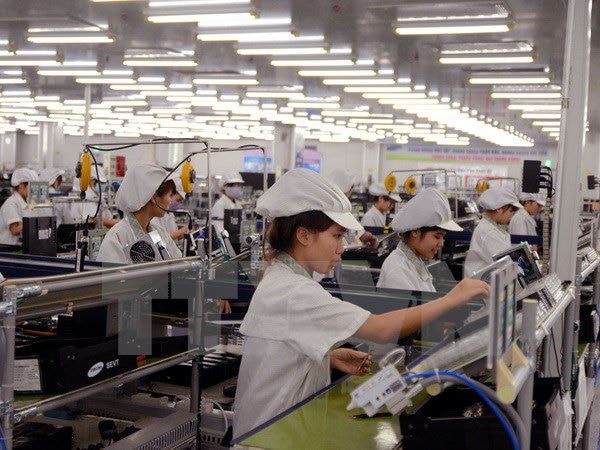Labor in integration: Excess quantity, lack of quality
Although considered a country with a "golden population," many experts frankly believe that Vietnamese workers will lose out at home when the ASEAN Economic Community (AEC) is established.
Low rate of trained workers, weak vocational skills, unprofessional working style, limited corporate culture and understanding of international law... are weaknesses of the Vietnamese workforce mentioned by experts.
Is the golden population a golden opportunity?
It is not by chance that experts have issued the above warning, because according to the General Statistics Office, Vietnam currently has about 48 million people of working age but the number of trained workers is only 30%. Overall, a small number of Vietnamese workers are currently capable of mastering new technologies.
In addition, the quality and structure of the labor force still have many shortcomings compared to the requirements of development and integration. Vietnam's economic structure is still mainly agricultural, so the rate of labor participating in the official labor market is still low, reaching about 30%.
 |
| Illustration photo: VNA |
Experts in the field of labor said that currently, about 45% of workers in the agricultural sector are almost untrained. Those in other fields who are trained have low qualifications and very poor foreign language skills. The low quality of human resources, leading to low labor productivity, is a real warning.
According to a recent report by the International Labor Organization (ILO), Vietnam's labor productivity is only about 1/5 of Malaysia's, 2/5 of Thailand's and 1/15 of Singapore's.
In a recent ILO/ADB study titled “ASEAN Community 2015: Managing Integration for Better Jobs and Shared Prosperity,” ILO and ADB experts said that Vietnamese workers lack expertise, are untrained, and their skills do not match market demands, and many workers need retraining…
This is one of the reasons why Vietnam's labor productivity is at the lowest level in Asia.
According to Dr. Nguyen Duc Thanh, Director of the Institute for Economic and Policy Research, Hanoi National University, Vietnamese workers have the advantage of being young, belonging to the "golden population" structure (the proportion of workers aged 18-45 accounts for a large number) - this is a population structure that many economies are dreaming of.
However, Vietnamese workers are often criticized for their foreign language skills and effective teamwork skills. Along with that, there is still a large gap between Vietnam's high-level personnel and those of other countries in the region.
Vietnam is in dire need of talented Vietnamese business managers who are competitive in regional markets. The workforce trained in recent years has largely focused on hard technical training and the ability to work independently, while integration requires more comprehensive skills.
According to Associate Professor, Dr. Pham Van Son, Director of the Center for Training Support and Human Resource Supply, Ministry of Education and Training, Vietnam's labor force is still limited in vocational skills, causing difficulties in absorbing applications and science and technology when participating in integration.
In addition, Vietnamese workers’ understanding of the business culture and laws of other countries is limited. In addition, poor teamwork spirit and industrial style are also weaknesses that make it difficult to compete when the labor market is opened.
Most experts believe that if Vietnamese workers do not soon overcome the situation of low productivity, and if teaching and training in vocational schools do not closely follow the development level of advanced countries in the region, Vietnamese workers will find it very difficult to compete in the regional labor playground, increase their advantages, and more dangerously, lose the market and job opportunities right at home.
Urgent need to improve labor quality
According to experts from ILO and ADB, Vietnam needs to urgently improve the quality of education and training in high schools and vocational schools.
This is to meet the rapid job growth for the middle-skilled labor group when the AEC officially takes effect at the end of 2015.
In addition, international experts also said that Vietnam needs to prioritize solutions to improve the quality and productivity of labor in the agricultural sector. At the same time, Vietnam needs to connect industry development policies and employment policies to maintain economic growth.
These solutions would be more effective if coupled with initiatives to strengthen employment services and advice, public employment programs targeting vulnerable groups, and support for small and medium-sized enterprises.
Associate Professor, Dr. Pham Van Son said that to enter the AEC, Vietnam needs to train and improve the quality of human resources.
With high-quality human resources, modern technology, professional management skills and understanding of the labor markets of other countries, Vietnam will certainly be proactive and successful in the integration process.
Accordingly, the breakthrough solution is to invest in developing high-quality human resources, improving production and business management skills and studying and learning from the experiences of advanced countries in ASEAN.
For Vietnamese enterprises, to retain employees, it is necessary to have appropriate policies on income, use and treatment in training and development, create promotion opportunities and a friendly and creative working environment so that human resources, especially high-quality human resources, can feel secure in their work and stay with the enterprise for a long time.
According to Vietnam+
| RELATED NEWS |
|---|
